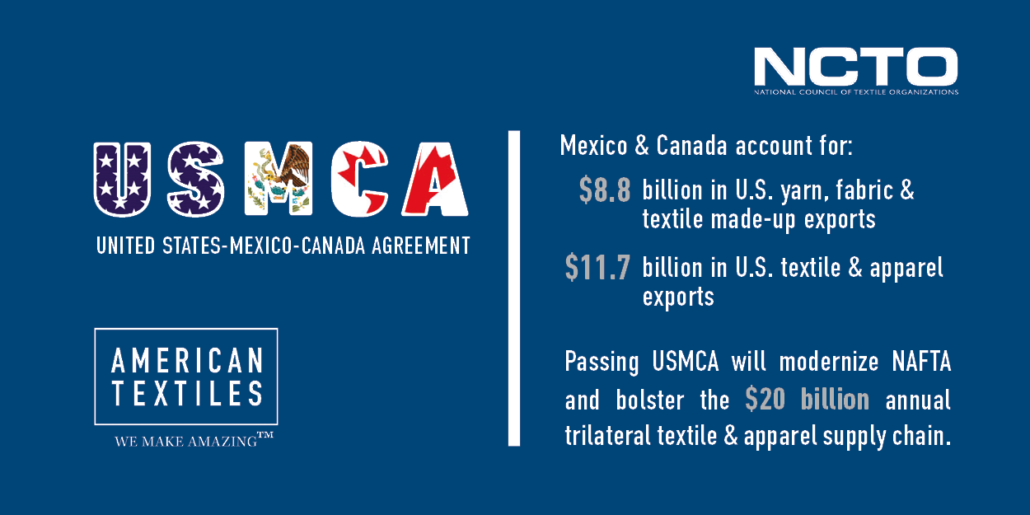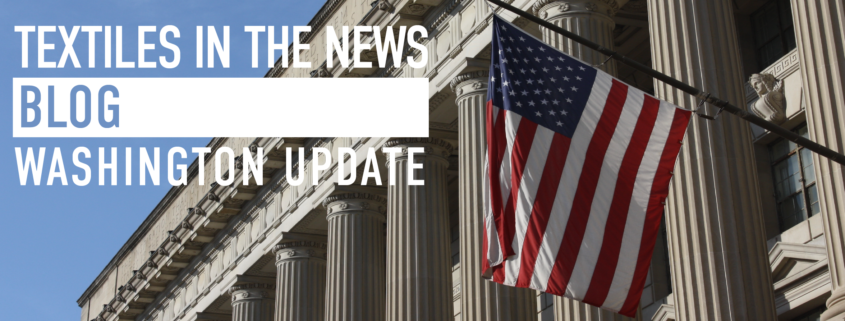Leib Oehmig, president and CEO of North Carolina-based Glen Raven, Inc., a 139-year-old global performance fabric manufacturer serving such markets as the awning, marine, furniture, protective, and military, has spent the past 30 years navigating the seismic changes in the industry brought about by globalization. As chairman of the National Council of Textile Organizations (NCTO), Oehmig has spent the past six months working with the association to help shape the policy debate in Washington and maintain a seat at the negotiating table on trade policy and regulations that have a significant impact on this expanding and dynamic industry that employs nearly 600,000 workers.
NCTO spoke with Oehmig in a wide-ranging Q&A, where he outlined his priorities for NCTO, which represents the full spectrum of U.S. textiles from fiber though finished sewn products, and stressed the importance of building strong ties with allies on Capitol Hill and in the administration to manage rapidly evolving trade policies. The Q&A also touches on the industry’s efforts on sustainability, the U.S.-Mexico-Canada Agreement (USMCA) and the outlook for the industry.
Q: What is the biggest change you’ve seen in the U.S. textile industry during your tenure at Glen Raven?
Oehmig: I think the biggest impact that I’ve seen—and it’s not just the textile industry but industry and business broadly—is globalization. When I joined Glen Raven we were very much a North American-centric organization. We were selling products to other countries, but we were not a truly global business. Now with locations in 17 countries and selling to more than 100 countries, the evolution of global markets has certainly been the biggest change that I have seen in business.
Our industry has tried to help shape the legislation and free trade agreements to ensure fairness and a level playing field for all manufacturers. It has influenced everything we do and everything we think about.
Q: What are your key priorities for NCTO, following your first six months as chairman of the association?
Oehmig: My priorities from the beginning have been to support both the association and NCTO leadership as we continue to navigate this transition period. I think any time you have a leadership change in any organization it really gives you an opportunity to take a deep dive and to give thoughtful consideration to your objectives and strategy to ensure that you are focused on the right things. [Kimberly Glas took over as president and CEO of NCTO on April 29, succeeding Augustine “Auggie” Tantillo who retired from the association.]
Under Auggie’s leadership, NCTO made incredible progress in terms of our presence and the credibility that we, as an association, achieved on Capitol Hill.
I think Kim has been very clear in her 100-day plan about wanting to take that deep dive—to do membership outreach and get out into the industry, not only to reengage but in some cases to introduce herself—and hearing from our membership to confirm that the priorites that we have been working on over the last several years remain relevant. She and the NCTO team have done a really nice job of collecting and incorporating feedback into the objectives Kim has set for NCTO.
Q: How do you think NCTO can best achieve results?
Oehmig: One thing that would be most helpful for NCTO is having an increased engagement level across our entire membership base. There are some large players out there, whether individual companies or associations, with whom we often find ourselves on the opposite side of an issue. We need every member company to be engaged for us to ensure that our message is getting through to the right people.
We talk a lot about our membership density. We need members to help NCTO in terms of establishing relationships with members of Congress in those districts where our members have a presence. Members of Congress want to hear from their constituents, which requires participation from the entire breadth of our membership to be most effective. I am hopeful that we will continue to see an elevation in our engagement level.
Lastly, member recruitment and expanding our membership base are top priorities. We will focus on determining how we can make a compelling case to a broader range of companies so that we can expand our membership thereby providing NCTO with the resources it needs to do its best work for our industry. If a company has ever pursued private representation, then they know what an incredible value an investment in NCTO represents. Having this level of talent advocating for our industry is something that we simply cannot take for granted. The global landscape for business is changing faster than at any time in history. Therefore, if our industry wants to help shape that landscape, we must be invited to the table.
Q: The administration has placed a strong emphasis on trade. How is the industry positioned to address impactful policy changes?
Oehmig: One of the things that NCTO has really done well over the last decade is earning a seat at the table when it comes to trade policy. NCTO is now viewed as a thought leader on trade and a resource for government when they start contemplating either modifications to current trade agreements or negotiating new trade agreements. I feel that has done more for the industry in the area of trade than anything else for the fact that now we are not always reacting to provisions within a negotiated trade agreement, we are actually in a position to help shape those agreements.
Q: Congress could take up the U.S.-Mexico-Canada Agreement (USMCA) this year. How important is that trade deal to the entire textile industry?
Oehmig: I feel it is critical. It is critical not only for the industry, but also for this hemisphere. You think about our largest trade partners—Mexico and Canada. We had over $17.4 billion in yarn, fabric and textile made-up exports to the world in 2018, and the countries that were buying the most—Mexico and Canada—were responsible for $8.8 billion of that. They are our two largest trading partners, making the USCMA region our most important export market for textiles and apparel combined at $11.7 billion in 2018.
Our member companies and people across our industry over the last 25 years since NAFTA was negotiated were encouraged to really engage with the NAFTA region and to establish our value chain throughout the region. That is in fact what the industry has done. We all recognize there were some improvements and modernization that could occur and we supported renegotiating NAFTA. Fortunately, our industry, NCTO and its leadership were consulted and had a seat at the table when it came to shaping what is now USMCA. We are certainly doing all that we can to encourage members of Congress with whom we have a relationship to get this agreement across the finish line.

Passing USMCA will modernize NAFTA and bolster the $20 billion annual trilateral textile & apparel supply chain. | Graphic: Rebecca Tantillo
Q: What is the current state of the industry? What are the challenges and headwinds at the moment?
Oehmig: If you look at the latest numbers that we had from 2018 over 2017, we saw growth in the domestic textile industry broadly. It wasn’t necessarily robust in terms of percentage growth but we did see growth. There were a lot of positive things that were benefiting the industry in 2018 and it has continued. There are still a lot of opportunities out there in the market.
In terms of the headwinds, it is just a general feeling of uncertainty. If you distill what keeps my peers up at night down into a single word, they cite general uncertainty, whether we’re talking about trade, geopolitical or global economic uncertainty. The fact that we are in the tenth year of this economic expansion, seems to have everyone waiting for the other shoe to drop.
While the fundamentals and metrics remain largely positive, there is just a growing sense of uncertainty. In my travels, I find that it is not just in the U.S., but a global sentiment. However, incredible opportunity remains for those who are prepared to adapt to the changing dynamics in global markets, and it is incumbent upon all of our members to continue to innovate, to continue to fill the pipeline with new products and services and to respond to those new opportunities.
Q: Are you seeing growth in the industry? The numbers are showing some growth over the past year or two.
Oehmig: If you look at the value of U.S. textile and apparel shipments, they were up from $73 billion in 2017 to $76.8 billion in 2018.
Those statistics reflect growth, which is also the case for U.S. exports of fiber, yarn, fabrics and apparel in 2018 vs. 2017. We do not have the benefit yet of knowing how 2019 will look in terms of the metrics, but I haven’t heard of anything that would completely unwind those statistics. It just depends on the market and the geography served.

The value of U.S. textile and apparel shipments and U.S. fiber, yarn, fabrics and apparel exports have increased since 2009.
Q: What are you seeing in terms of the industry’s commitment and efforts to incorporate more sustainable business practices?
Oehmig: Maybe it’s just because of the nature of who we are, but I feel that we do not do a very good job of highlighting all of the incredible work that our industry is doing in the area of sustainability. There are numerous examples where our industry is taking a leadership role and for that we should be proud. I know that our member companies want to be viewed as great corporate citizens in every community and market they serve. I do not feel this is new. However, it is clear that consumers are going to press us to increase our environmental consciousness in the things that we’re doing to create sustainable practices and to be even more thoughtful, both environmentally and socially. Not only do our member companies know that it is the right thing to do but they also recognize that we are going to be held accountable by our customers and consumers in general.
Q: What is the outlook for the industry with so many policy changes on the trade front and global business pressures?
Oehmig: I feel very optimistic and encouraged for our industry. Clearly there will always be challenges and we need every company to engage in the process. Every company or group that benefits from a strong North American textile industry must become a member of NCTO. We need for every industry participant to make an investment in ensuring that our voice is heard in Washington. It takes headcount. Therefore, the work and the investment cannot be left to a few.
Individual companies must continue to innovate. When we think about the markets our industry serves, the products and services we provide, we all must be focused on creating clear points of differentiation that are valued by consumers. If we continue to bring innovation to the market, that will give us the greatest chance of winning. We need to engage with policymakers to help shape policy, to give us an opportunity to bring innovative ideas and services to the marketplace and not get tangled up in an overly regulated environment. If those things happen then I feel really good where we are as an industry. And if we continue to invest in NCTO so that our team can do its best work, then I feel the combination of a strong group of companies who represent our membership, along with the leadership of NCTO in our engagement with policymakers, will result in some great outcomes for our industry.





